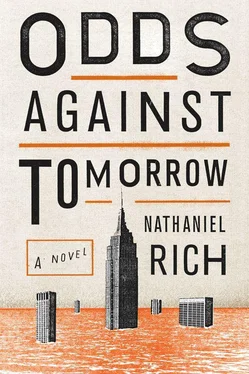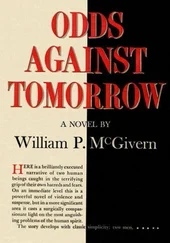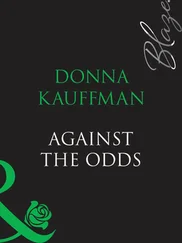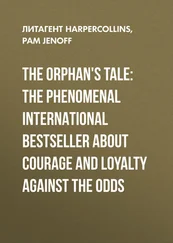“What’s your story?” asked Joseph McIntyre, a man with a flat nose and large brown eyes who looked as if he hadn’t slept for a week. He sidled up with his lunch tray. “How’d you end up here?”
“We took a canoe through the flooded city,” said Jane. “We went to Maine, but the situation there was even worse. So we came back.”
“You don’t say.”
Jane nodded, smiling uneasily. “I do,” she said, but Joseph McIntyre just gaped back at her. Finally Jane asked for his story. The man smiled in gratitude.
This became a pattern. Strangers asked questions, but they didn’t seem particularly interested in answers. Even when Jane recited the gruesome details — the floating bodies, the brush with Nybuster and his caroming golf balls — they gave her only blank stares and patient smiles.
“Is that so?” said Ruben Mota. “That sounds scary.”
“Really?” said Olga Lipinski.
“My,” said Harold Wolacz. “You had it rough.”
Their friendliness, Mitchell began to realize, was the first part of a ritual. In certain African societies, when you meet a person in the street, you can’t merely ask how he’s doing; you must also inquire about his health, family, and occupation before exchanging various blessings and hymns. The encounters at the camp worked in a similar way. The refugees would listen, patiently, to another person’s story, but only so long as they could share their stories next. They were desperate to unburden themselves of their personal horrors. The Lipinskis had waited for two days on their roof, dehydrating, until they were airlifted by a rescue basket into a Coast Guard helicopter. The Motas, a Dominican couple in their fifties, were trapped in their dining room; they stood on a coffee table for eighteen hours watching as the water slowly rose to their chins. A patrol boatman, hearing their screams, took an ax to their door and rescued them. Finally there was Maya Dupre, a robust college sophomore who told her story with wild gesticulations. She had swum out the window of her second-floor apartment in Homecrest. The night after the storm she slept on the elevated F train platform above McDonald Avenue, lying out in the open air. “For the first time in my life,” she said, “I could see the stars.” She was proud of that line. She repeated it and repeated it.
“I could make her see some more stars,” said Jane between bites of a government-issued ham sandwich. Then her mouth puckered, and she removed a curled strip of plastic wrap from her mouth.
And there were those who, like Mitchell, didn’t want to talk. These were the diminished people, unnaturally drawn and tortured, who haunted the Red Cross table. Aid workers gamely took down names and any information that might be used to identify a body. Some of the bereaved carried photographs of the missing; some wore the photographs on chains around their necks. They walked around the camp like zombies, from trailer to trailer, hoping in their desperation to discover a familiar face. Others gathered around the muted flatscreen television that had been hung from the side of the Red Cross trailer. The television was tuned to a local news network that periodically flashed images of the missing and scrolled the names of those who had registered at FEMA checkpoints. But nearly every time Mitchell walked by this television, his own picture appeared on the screen. It was the photograph Charnoble had taken on his first day of work at FutureWorld; he looked baffled and alarmed, and the flash had turned him several shades paler. It was like seeing a ghost — a ghost of a former self, a painfully naive young man who had no idea what kind of nightmare was about to swallow him. He told himself to stop going near the Red Cross trailer, but every hour or so he found himself back there, where he would linger until his face appeared under increasingly large font with increasingly hysteric captions:
HE CAME FROM THE FUTURE
WHY DIDN’T WE LISTEN?
THE MAN WHO KNEW TOO MUCH
While Mitchell wandered the camp, Jane gave interviews. Once, when Mitchell’s photo appeared on the television, a tagline at the bottom of the screen appeared: “On the line: Jane Eppler, spokeswoman, Future Days.” He looked around and spotted Jane standing at the shore forty yards away, speaking into her headset, making exuberant motions with her hands.
Nearly five days had passed since Tammy made landfall, and everyone who could leave Randall’s Island had already left. The refugees who remained were determined to stay put. They were ready to return to their homes. It was a reasonable position. There was only one problem: the water hadn’t gone down. Behind the administration desk, set up on what had been public tennis courts, a large whiteboard listed neighborhoods next to their flood-depth figures. Every hour the numbers were updated by a woman in one of the ubiquitous navy FEMA baseball caps. She read the latest depths from a clipboard. With her other hand she gripped a marker, using the side of her fist to dab away the old figures and scribbling the new ones in red ink. There was a mood of frantic expectation around the clipboard. Other than the Red Cross television, this was the refugees’ main portal to the rest of the world. All they knew of the devastation was what they had seen firsthand, and rumors. Some reported that the city was completely empty; there was no electricity, no drinking water, and the floodwater was tainted with toxic waste. Others claimed that hundreds of thousands of New Yorkers were already returning to their neighborhoods, that outside of lower Manhattan and the coastal areas, there was little damage other than fallen trees. So they scrutinized the only hard data they had: the water level figures on the whiteboard. They puzzled over them, as if the numbers alone could reveal the myriad unknown stories of the storm-wrecked city.
The water in the neighborhoods along the East River — Vinegar Hill, Brooklyn Heights, Sunset Park, and, to a lesser extent, Red Hook — had dropped from feet to inches. But those neighborhoods that fronted the sea, in lower Brooklyn and Queens — from Sea Gate (12.5 feet) to East New York (5 feet) and even parts of East Flatbush (10 inches) — had barely changed. By evening the numbers decreased, but in the morning they returned to their previous levels. Every time a higher figure appeared there were groans of outrage from the crowd. The FEMA woman, shrugging, blamed imprecise measurements, but Mitchell knew better. The fluctuations weren’t due to faulty equipment; the culprit was the tide. Washing in and washing out. And every time the water receded, it swept out traces of civilization — walls, furniture, bodies.
Nor were the refugees pleased to see that while their neighborhoods in the outer boroughs were turning to swamp, the water in lower Manhattan was dropping rapidly. Manhattan, however, had help. The island had been surrounded by Mosquitoes — supertankers with suction pumps built to clean up oil spills. The Mosquitoes vacuumed millions of barrels of water every hour and pumped the effluent into the bight. Another day of the Mosquitoes slurping up Manhattan’s water and, according to the whiteboard, the borough would be dry.
“How about that?” said Jane. “We could be having dinner at the Palm tomorrow night. I could use a steak. Rare. Salted and charred. Side of half-and-half. Side of creamed spinach.”
“Jane.”
“Side of thick-cut bacon .”
“Dry doesn’t mean safe. They’ll have to send thousands of assessors, engineers, garbage crews. Imagine the amount of trash. Millions of tons, mountains, skyscrapers of trash.”
Jane’s mouth went slack.
“What,” said Mitchell. “What is it?”
“It’s like you don’t even want to go back.”
“That’s not true,” he said. But it was true. He could admit that much to himself.
Читать дальше












